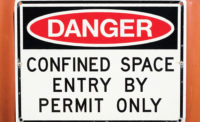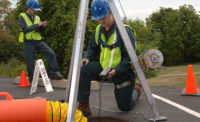Is your facility prepared for such an event? Can you count on your local fire department to be on site and ready in five minutes? Are they always available? Increasingly, facilities with confined spaces are turning to outside contractors for help, either to train on-site team members or to provide rescue.
The key to successful special operations response is training. Not only must your entry team be fully trained, but a good rescue team needs years of experience, practice and exercise. In fact, one expert says the confined space rescue team will spend far more time training than on actual calls. According to Chase Sargent, president of Spec Rescue International, training time and quality can make the difference between a false sense of security resulting in failure and a successful rescue.
Three training levels
In his bookConfined Space Rescue, Sargent provides specifics about how to choose team members, how to train and how to organize a rescue. Sargent says you need people who can work in stressful, alien environments, think for themselves and still be team players. Drawing from NFPA 1690, he recommends three levels of training: awareness, operations and technician.1) Awareness - Awareness-level personnel are sufficiently trained to assess the situation, decide which resources are necessary and participate in the operation. Not considered rescuers, these people have basic skills helpful to evaluate and control a technical rescue incident.
2) Operations - At the operations level, training provides the ability to recognize hazards, use equipment and participate in a technical rescue operation. These people are team members with limited training and experience in the actual confined space rescue.
3) Technician - Technician-level training includes additional, more comprehensive classroom training on atmospheric monitoring, hazardous materials, planning, incident management, legal updates, team decision-making, advanced rope skills, marine operations and other specialty subjects as appropriate.
A fully operational team includes members on all three levels. All members are awareness trained, some members at operations level provide support and staffing at the incident, and technicians make up specialty teams. Each group supports the other.
Team-building
Training, according to Sargent, can be provided in-house, by private contractors, through state and local institutions or by setting up a train-the-trainer program. Sargent's list of ways to select a private company is specific and based on 26 years with the Virginia Beach (Va.) Fire Department and FEMA Team 2.Training sessions are designed around building teams, working with particular equipment in confined spaces, preparing for the psychological aspects of this type of rescue as well as building basic skills. Once training begins, teams can be built and challenged to compete against one another to beat each other's time. Members encouraged to think creatively come up with better ways to complete a given task faster. Trainers provide the trainees constant feedback and instruction.
Later, when team members show managed training expertise, they advance to full-mission-profile exercises in which no facilitation from trainers is provided until the entire training scenario is complete. This level of training requires props, settings such as vaults, sewers, towers, reactor vessels and silos. Adding simulated gas releases from high-pressure airlines, electrical failures and high-pitched noises can provide the training quality required.
Specific requirements
Training is based on NFPA 1670, which lays out specific knowledge and skill requirements for each level - awareness, operations and technician - as well as for the instructor. The consensus standard provides guidelines and requirements for planning and providing technical rescue services. In addition to confined space rescue, 1670 details six other types of special operations rescue.
Teams should train at least once a quarter for an entire day, in classrooms, workshops and full-mission profile exercises, and receive updates to keep each member well above minimum proficiency. Since confined space incidents regularly result in medical emergencies, technical-rescue medics and physicians must also be specially trained. Sargent recommends recruiting experienced medics and physicians as part of the team.
Lots to consider
Other elements required to establish an on-site rescue team are proper equipment and a fully developed incident command structure. Included in Sargent's book are detailed incident command organization charts, checklists and other helpful forms for facilities wishing to develop a confined space rescue team. The book also contains the protocol developed by OSHA for choosing an appropriate rescue service.Some other considerations when developing a team include:
- IDLH potential - If your permit-entry includes the possibility of an IDLH atmosphere developing should ventilation fail, you need a rescue team standing by at the permit space during entry.
- Travel time - Consider how quickly the selected rescue service can get from its location to yours. Factors include road conditions, traffic, vehicle reliability and drivers' training and skill level.
- Availability - Will the service actually be available when you need them? Do they at certain times have only limited hours? How will they notify you if the service becomes unavailable when an entry is planned?
Planning for confined space entry starts long before the first entrant breaks the opening plane. Rescue planning must begin even before the testing and space preparation in order to have a team ready to pull out a victim in the required number of minutes.
SIDEBAR: By the book
Confined Space Rescueby Chase Sargent, copyright 2000 by Fire Engineering Books & Videos, a Division of Penn Well Corp., Park 80 West, Plaza 2, Saddle Brook, NY 07663.
A 26-year veteran in rescue operations, Chase is battalion chief and paramedic with the City of Virginia Beach Fire and Rescue Dept. He is president of Spec Rescue in Virginia Beach.
SIDEBAR: Who's on the team?
In his book,Confined Space Rescue, Chase Sargent says rescue team members should be people who can:
- Handle stressful situations
- Work in alien environments
- Think for themselves
- Be team players

